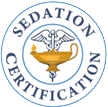Conscious Sedation
Conscious sedation provides a safe and effective option for patients undergoing minor surgeries or diagnostic procedures. The number and type of procedures that can be performed using conscious sedation have increased significantly as a result of new technology and state of the art drugs. Conscious sedation allows patients to recover quickly and resume normal daily activities in a short period of time.
What are MODERATE and DEEP SEDATION
Moderate and deep sedation induces an altered state of consciousness that minimizes pain, discomfort and decreases anxiety through the use of pain relievers and sedatives. Patients, who receive conscious sedation, usually are able to speak and respond to verbal cues throughout the procedure communicating any discomfort they experience to the provider. A brief period of amnesia may erase any memory of the procedure.
WHEN is moderate sedation administered?
Conscious sedation is administered in hospitals, outpatient facilities, e.g., ambulatory surgery centers, doctor’s offices, etc., to facilitate procedures such as the following:
- Breast biopsy
- Vasectomy
- Minor foot surgery
- Minor bone fracture repair
- Plastic/reconstructive surgery
- Dental prosthetic/reconstructive surgery
- Endoscopy (example: diagnostic studies and treatment of stomach, colon and bladder)
- Emergency Room
- Interventional Radiology
WHO CAN ADMINISTER moderate sedation?
Moderate sedation is extremely safe when administered by qualified providers. Certified Registered Nurse Anesthetists (CRNAs), anesthesiologists, other physicians, dentists, and oral surgeons are qualified providers of moderate sedation. Specifically trained Registered Nurses Physicians and Physician Assistants may assist in the administration of moderate sedation.
WHO SHOULD MONITOR conscious sedation?
Because patients can slip into a deep sedation, proper monitoring of conscious sedation is necessary. Healthcare providers monitor patient heart rate, blood pressure, breathing, oxygen level and alertness throughout and after the procedure. The provider who monitors the patient receiving moderate sedation should have no other responsibilities during the procedure and should remain with the patient at all times during the procedure.
What are the Side Effects of moderate sedation?
A brief period of amnesia after the procedure may follow the administration of sedation. Occasional side effects may include headache, hangover, nausea and vomiting or unpleasant memories of the surgical experience.
What should PATIENTS EXPECT immediately following the surgical or diagnostic procedure?
A qualified provider monitors the patient immediately following the procedure. Written postoperative care instructions should be given to the patient to take home. Patients should not drive a vehicle, operate dangerous equipment or make any important decisions for at least 24 hours after receiving sedation. A follow-up phone call usually is made by the healthcare provider to check on the patient’s condition and answer any remaining questions.
QUESTIONS to ask about conscious sedation
The following is a list of questions patients should ask prior to the surgical or diagnostic procedure:
* Will a trained and skilled provider be dedicated to monitoring me during conscious sedation?
* Will my provider monitor my breathing, heart rate, and blood pressure?
* Will oxygen be available and will the oxygen content of my blood be monitored?
* Are personnel trained to perform advanced cardiac life support?
* Is emergency resuscitation equipment available on-site and immediately accessible in the event of an emergency?
* Will a trained and skilled provider stay with me during my recovery period and for how long?
* Should a friend or family member take me home?
